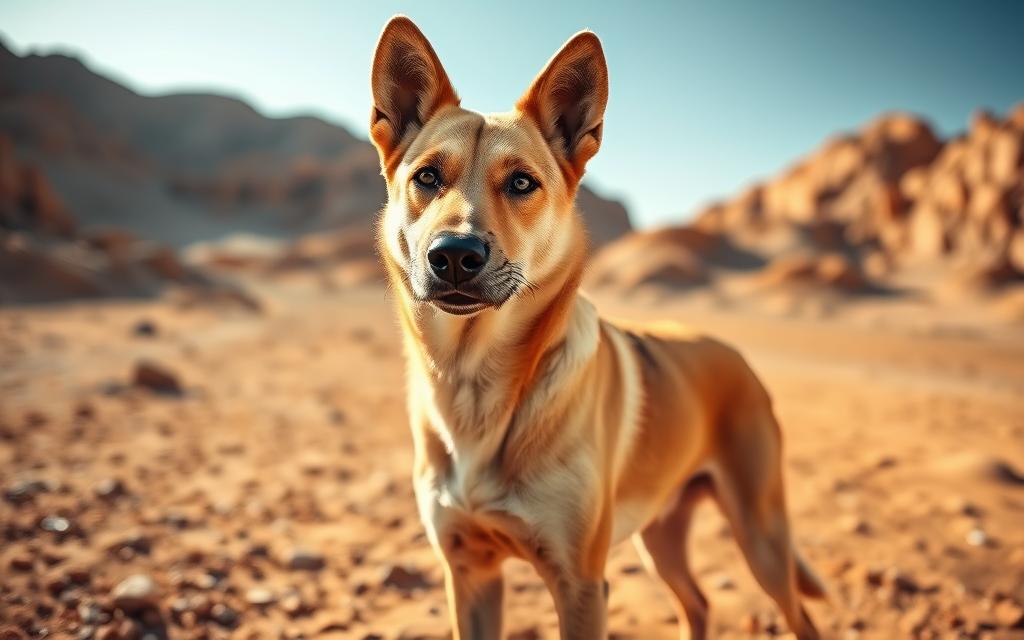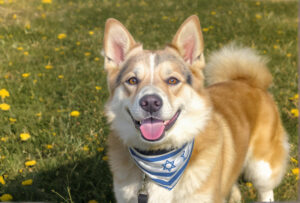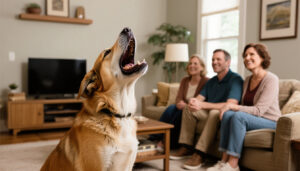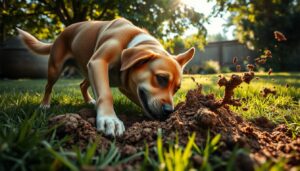
The Canaan Dog is an ancient breed with roots from the biblical era. It’s not just Israel’s national dog but also a symbol of resilience and adaptability.
This breed has evolved over centuries in the harsh desert. It has developed unique traits that set it apart from other breeds. Known for its intelligence and loyalty, the Israeli Canaan Dog is a great companion and working dog.
The Canaan Dog holds a special place in Israel’s history and culture. As we delve into its story, we discover the qualities that have made it a beloved national symbol.
- Ancient Origins: From Desert Survivor to National Symbol
- Physical Characteristics of the Canaan Dog
- The Remarkable Journey of Dr. Rudolphina Menzel's Discovery
- Understanding Canaan Dog Temperament and Intelligence
- From Working Dog to Family Companion
- Health and Longevity: A Naturally Hardy Breed
- Conservation Efforts and Modern Breeding Programs
- Living Heritage: Why the Canaan Dog Represents Israel's Spirit
- FAQ
Ancient Origins: From Desert Survivor to National Symbol
The Canaan Dog, Israel’s national breed, has a long history. It dates back thousands of years. The breed’s roots are in the biblical era, with ancient texts mentioning dogs like the Canaan Dog.
Biblical References and Historical Records
The Canaan Dog’s story is one of survival and adaptability. Ancient records and biblical texts show its long history in the region. These texts describe the dogs as adaptable, loyal, and intelligent, traits still seen today.
Evolution in the harsh Negev Desert shaped the breed’s unique features. Its medium size, erect ears, and bushy tail are key. These traits helped the Canaan Dog survive in the desert, making it a true desert survivor.
Evolution in the Negev Desert
The Negev Desert posed extreme challenges for the Canaan Dog. Over centuries, it adapted to these challenges. This adaptation shaped its physical and behavioral traits, showcasing natural selection.
The Canaan Dog’s evolution in the Negev is a story of gradual adaptation. It developed necessary traits to survive and reproduce, ensuring its survival.
Modern Recognition Timeline
The Canaan Dog’s journey to being recognized as Israel’s national breed is remarkable. Decades of breeding programs and research led to its official recognition. This recognition celebrates its unique history and characteristics.
This recognition not only honors the breed’s past but also secures its future. It ensures the Canaan Dog remains a cherished national symbol of Israel.
Physical Characteristics of the Canaan Dog
The Canaan Dog is a medium-sized breed. It has a strong build and an adaptable coat from its desert origins. Males are usually 50-60 cm tall and weigh 18-25 kg.
The breed’s coat is short to medium in length, dense, harsh, and straight. This coat helps the Canaan Dog survive in harsh environments.
The Canaan Dog’s coat comes in many colors. You can find desert colors like sand, gold, red, or cream. There are also red-brown, white, black, or spotted options. This variety shows the breed’s genetic diversity.
| Characteristic | Description |
|---|---|
| Size | Medium (50-60 cm height, 18-25 kg weight) |
| Coat Length | Short to medium |
| Coat Type | Dense, harsh, straight |
| Colors | Sand, gold, red, cream, red-brown, white, black, spotted |
If you’re looking at Canaan Dog puppies, knowing these physical traits is key. It gives important Canaan Dog information to both potential owners and fans.
The Remarkable Journey of Dr. Rudolphina Menzel’s Discovery
In the 1930s, Dr. Rudolphina Menzel started a groundbreaking journey to find and save the Canaan Dog breed. Her work was key in shaping the breed’s future and showing its unique traits.
Dr. Menzel first worked on picking dogs that showed the breed’s traditional qualities. This led to a breeding program aimed at keeping the Canaan Dog’s natural skills and traits.
The 1930s Breeding Program
The breeding program Dr. Menzel started in the 1930s aimed to:
- Find and choose dogs with good traits
- Plan a breeding strategy to improve these traits
- Make a strong and healthy breed
This program helped keep the breed alive and set the stage for its growth.
Military and Service Applications
Dr. Menzel’s work showed the Canaan Dog’s great potential for military and service roles. The breed’s smarts, quickness, and loyalty made it perfect for tasks like guarding and carrying messages.
The Canaan Dog’s ability to adapt and learn made it great for many service jobs.
Establishment of Breed Standards
Dr. Menzel’s efforts also led to the establishment of breed standards for the Canaan Dog. This was important for the breed to be recognized worldwide and to be saved for future generations.
The breed standards set by Dr. Menzel and others defined what a Canaan Dog should look like, act like, and feel like.
The Canaan Dog’s journey from being unknown to being a symbol of Israel shows Dr. Menzel’s hard work and vision.
Understanding Canaan Dog Temperament and Intelligence
The Canaan Dog comes from ancient desert roots. It’s known for its smarts and protective side. This makes it great at herding, guarding, and even search and rescue.
This breed is very loyal and protective of its family. It’s a top-notch watchdog because of its intelligence and protective instincts. But, it also has a gentle side, making it a loving pet.
| Trait | Canaan Dog | German Shepherd | Golden Retriever |
|---|---|---|---|
| Intelligence | High | High | High |
| Loyalty | Very High | High | High |
| Protective Nature | Strong | Strong | Moderate |
The Canaan Dog is smart, loyal, and protective. It’s perfect for many roles, from work to family pet. Its strong bond with family and watchful nature make it a great companion and guardian.
From Working Dog to Family Companion
The Canaan Dog has changed from a working dog to a family pet. It shows how versatile and adaptable it is. This breed fits well into many families today.
Adaptation to Modern Living
The Canaan Dog can live in many places. It was made for the harsh Negev Desert but now lives in different climates. Its smartness and resourcefulness make it great for active families.
Training Requirements and Challenges
Training a Canaan Dog needs patience, consistency, and positive feedback. They are independent, making training hard for new owners. But, with the right training, Canaan Dogs can do well in obedience and agility.
Success Stories in Various Roles
Canaan Dogs have done many jobs, like herding and guarding. They are also good at search and rescue. Many have become loving family pets, offering companionship and protection. They show their intelligence, loyalty, and protective side in these roles.
In summary, the Canaan Dog’s shift to a family pet is a story of adaptability and loyalty. With the right training and care, it can be a valued member of many families.
Health and Longevity: A Naturally Hardy Breed
The Canaan Dog is known for its robust health and remarkable longevity. It comes from harsh desert environments. This has made it strong and able to live in many conditions.
This breed is generally healthy, living from 12 to 15 years or more. It needs proper care and vet visits. But, like all breeds, it can face health problems. Issues like hip dysplasia and progressive retinal atrophy can occur.
Patella luxation is another problem, where the kneecap slips out of place. This can hurt or cause pain. But, good breeding practices can lower these risks. Breeders who test for health and genetic diversity help a lot.
To keep a Canaan Dog healthy, regular vet visits are key. These include check-ups, shots, and screenings. Also, a good diet, exercise, and mental games are important for its well-being.
In short, the Canaan Dog’s natural strength and long life make it special. Knowing about health issues and acting early can help it live a happy, healthy life.
Conservation Efforts and Modern Breeding Programs
Efforts to save the Canaan Dog are underway. Both local and international breeding programs are involved. Saving this ancient breed needs a mix of actions, like managing its population, starting global breeding, and facing challenges.
Population Status
The Canaan Dog’s population is a worry for breeders and conservationists. Current estimates show a small global population. This makes saving the breed very important. The Israel Kennel Club and others are working hard to watch and manage the breed’s numbers.
Global Breeding Initiatives
Global breeding efforts are key to improving the Canaan Dog’s genetic mix. Breeding programs are not just in Israel but also in other countries. They aim to build a strong global population. Kennel clubs, breeders, and Canaan Dog fans worldwide are working together.
- Collaboration between international breeders to enhance genetic diversity.
- Development of breeding programs tailored to the Canaan Dog’s specific needs.
- Promotion of the breed through events and educational programs.
Preservation Challenges
Despite progress, challenges in preserving the Canaan Dog remain. Limited genetic diversity and a small population size are big worries. To tackle these, breeders, conservationists, and kennel clubs must work together. They need to create and use effective conservation plans.
- Enhancing genetic diversity through carefully planned breeding programs.
- Increasing awareness about the Canaan Dog to attract new breeders and owners.
- Supporting research into the breed’s health and longevity.
Living Heritage: Why the Canaan Dog Represents Israel’s Spirit
The Canaan Dog is a key part of Israeli heritage. It shows the nation’s strength and ability to adapt. As Israel’s national dog, its history mirrors the country’s journey of survival and growth.
The Canaan Dog is a big part of Israel’s identity. It connects people to their land and history. Learning about the Canaan Dog’s history helps us understand Israel’s struggles and triumphs.
The Canaan Dog inspires pride in Israelis. It reminds them of their history and unwavering spirit. By celebrating the Canaan Dog, Israel honors its cultural heritage and values like strength, loyalty, and resilience.











